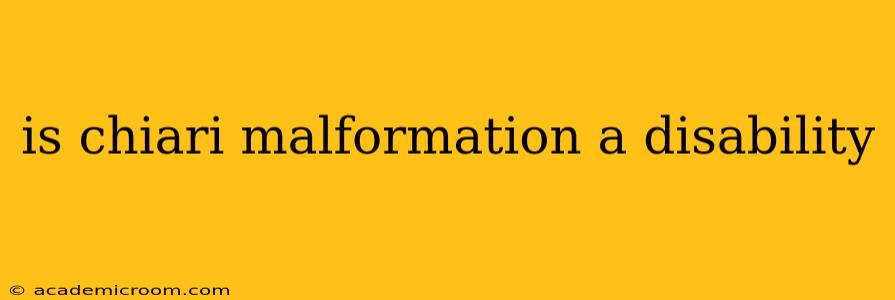Chiari malformation is a condition where the cerebellum, the lower part of the brain, extends down into the spinal canal. Whether or not it constitutes a disability is a complex question with no simple yes or no answer. It depends heavily on the individual's specific symptoms, the severity of the malformation, and how it impacts their daily life.
While Chiari malformation itself is a neurological condition, its impact on an individual's functionality determines its classification as a disability. This means that two people with Chiari malformation might have vastly different experiences and qualify differently under disability laws.
What are the Symptoms of Chiari Malformation?
The symptoms of Chiari malformation can vary widely, ranging from mild to severe. Some individuals may experience no noticeable symptoms at all, while others face significant challenges in their daily routines. Common symptoms include:
- Headaches: These are often severe and located at the back of the head.
- Neck pain: Persistent neck pain is a frequent complaint.
- Balance problems: Difficulty with coordination and balance can impact mobility.
- Numbness and weakness: These sensations may be felt in the arms, hands, legs, or feet.
- Vision problems: Blurred vision, double vision, or other visual disturbances.
- Difficulty swallowing (dysphagia): This can make eating and drinking challenging.
- Speech difficulties (dysarthria): Slurred speech or difficulty articulating words.
- Cognitive difficulties: These can include issues with memory, concentration, and executive function.
How Does Chiari Malformation Impact Daily Life?
The impact of Chiari malformation on daily life is directly related to the severity of symptoms. Mild cases might only cause occasional headaches or discomfort, requiring minimal adjustments to daily routines. However, severe cases can significantly impair daily living, potentially affecting employment, social activities, and overall quality of life. Activities like working, driving, and even simple tasks might become challenging.
Can Chiari Malformation Qualify for Disability Benefits?
Whether or not Chiari malformation qualifies for disability benefits depends on several factors, including:
- Severity of symptoms: The more severe and debilitating the symptoms, the stronger the case for disability benefits.
- Impact on daily living: Documentation showing significant limitations in daily activities is crucial.
- Medical evidence: Comprehensive medical records, including diagnostic imaging and physician reports, are essential.
- Specific disability criteria: Each disability program has its own criteria for determining eligibility.
The process of applying for disability benefits can be complex and challenging. It's advisable to seek assistance from disability advocates or legal professionals.
Does Chiari Malformation Affect Employment?
The impact of Chiari malformation on employment depends heavily on the nature of the job and the severity of symptoms. Some individuals with Chiari malformation may be able to continue working without significant changes, while others may require accommodations or modifications to their work environment. In severe cases, employment may become impossible.
What are the Treatment Options for Chiari Malformation?
Treatment options for Chiari malformation range from conservative management (such as pain medication and physical therapy) to surgery. The choice of treatment depends on the severity of symptoms and the individual's overall health. Surgical intervention might be necessary to alleviate pressure on the brainstem and spinal cord.
Conclusion: A Case-by-Case Determination
In conclusion, whether Chiari malformation is a disability is determined on a case-by-case basis. The severity of symptoms, their impact on daily life, and the individual's ability to function determine whether it qualifies as a disabling condition under various legal and social frameworks. It's crucial to consult with medical professionals and potentially disability advocates to understand the individual implications and options available. This information is for general knowledge and should not be considered medical or legal advice. Always seek professional guidance for your specific situation.
